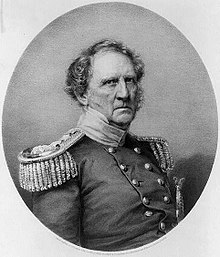The Man That Was Used Up
| "The Man That Was Used Up" | |
|---|---|
Periodical) | |
| Publication date | August 1839 |
"The Man That Was Used Up", sometimes subtitled "A Tale of the Late Bugaboo and Kickapoo Campaign", is a short story and satire by Edgar Allan Poe. It was first published in August 1839 in Burton's Gentleman's Magazine.
The story follows an unnamed
Plot summary
An unnamed
The narrator wants to learn more about this heroic man. He finds that people do not seem to want to speak about the General when asked, only commenting on achievements of the "wonderfully inventive age" and how "horrid" the Native Americans whom the General had fought against had been. Whenever anyone seems on the verge of revealing some great secret about Smith, a distraction occurs to end or sidetrack the conversation. The narrator becomes increasingly determined to discover all he can and eventually decides to speak directly to Smith.
When he visits Smith's home, he finds an oddly shaped bundle on the floor that begins to speak. It is Smith himself, whose servant begins to "assemble" him as he converses with the narrator. Limbs and other body parts are attached one at a time, including a wig, a glass eye, and false teeth, until the man stands "whole" and ready to present himself in public. During his battles against the Native Americans, he was captured and severely mutilated; much of his body now consists of prostheses, which must be attached every morning and removed at night. The narrator now understands Smith's secret — he is "the man that was used up."
Publication history

The story was first published in Burton's Gentleman's Magazine in August 1839[1] and collected in Poe's 1840 anthology Tales of the Grotesque and Arabesque. In 1843, Poe had the idea to print a series of pamphlets with his stories, though he printed only one: "The Man That Was Used Up" paired with "The Murders in the Rue Morgue". It sold for 12 and a half cents.[2]
Analysis

Critics have identified John A. B. C. Smith as representing General
According to scholar Leland S. Person, Poe is using the story as a critique of male military identity, which he knew well from his own military career and his studies at the
The opening epigraph to the story is from Le Cid by Pierre Corneille and translates to:
- "Weep, weep, my eyes and float yourself in tears!
- The better half of my life has laid the other to rest."[3]
The story bears a resemblance to "A Beautiful Young Nymph Going to Bed", a satiric
Some consider "The Man That Was Used Up" to be one of the earliest works of science fiction about cyborgs.[11]
References
- ISBN 0-8018-5730-9
- ^ Ostram, John Ward. "Poe's Literary Labors and Rewards" in Myths and Reality: The Mysterious Mr. Poe. Baltimore: The Edgar Allan Poe Society, 1987: 40.
- ^ ISBN 0-8160-4161-X
- ^ ISBN 0-8154-1038-7
- ^ Eisenhower, John S. D. Agent of Destiny: The Life and Times of General Winfield Scott. University of Oklahoma Press, 1999, p. 124.
- ISBN 0-8071-2321-8
- ISBN 0-8223-1311-1
- ^ ISBN 0-19-512150-3
- ISBN 978-0-8018-5332-6
- ISBN 0-674-06565-4
- ^ "SFE: Cyborgs". sf-encyclopedia.com. Retrieved 2023-01-21.
External links
 Works related to The Man That Was Used Up at Wikisource
Works related to The Man That Was Used Up at Wikisource The Works of Edgar Allan Poe, Raven Edition, Volume 4 public domain audiobook at LibriVox
The Works of Edgar Allan Poe, Raven Edition, Volume 4 public domain audiobook at LibriVox
